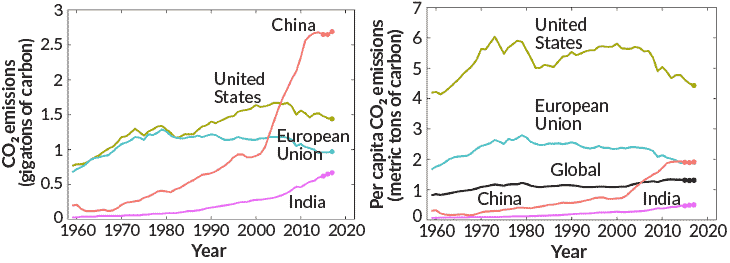Carbon dioxide emissions will hit a record high globally in 2018
Releases due to fossil-fuel use rose 2.7 percent, the latest tally shows

Most cars and trucks burn fossil fuels, which produce carbon dioxide and contribute to climate change.
egdigital/iStockphoto
Global carbon-dioxide emissions are expected to hit a record high in 2018. This is despite urgent calls for countries to cut back. Those calls have come from climate scientists, international groups such as the United Nations — and kids and teens.
Worldwide, fossil-fuel use is projected to pump 2.7 percent more CO2 into the air this year than in 2017. Last year, such emissions totaled some 9.9 billion metric tons (gigatons). Emissions rose slowly from 2014 to 2016. That has now changed. This year marks the second in a row where CO2 levels have risen a lot. Such emissions fuel global warming and climate change.
The new data come from a report called the Global Carbon Budget. It was published online December 5 in Earth System Science Data. (The report uses data through early November to predict emissions for the whole year.)
News of the 2018 increase comes on the heels of the Fourth National Climate Assessment. Scientists put this big report together for the U.S. government. The report projects dire impacts in the United States if it doesn’t cut back its CO2 emissions. That’s because CO2 is a greenhouse gas. Such gases act like a blanket around the planet, trapping the sun’s heat close to the surface. The more CO2 that’s emitted, the more heat that gets trapped.
(story continues below image)

On a per-person basis, the United States is the world’s largest CO2 emitter. It released 4.4 metric tons per person in 2017. In comparison, people in Europe average only about half that much. Total U.S. CO2 emissions from fossil-fuel use grew 2.5 percent in 2018. That is even as the United States has been using more renewable sources of energy than ever. Renewables, such as wind and solar power, don’t emit greenhouse gases.
Overall, India will see the biggest bump up in CO2 releases from fossil-fuel use this year. It’s spewed 6.3 percent more than in 2017. Part of the reason is a rapid growth in its industries. Bringing electricity to more rural people in India also has boosted its emissions. Per person, though, India’s emissions are lower than the global average.
Overall, China is the largest CO2 emitter. Its releases climbed 4.7 percent in 2018. Both India and China are making attempts to shift away from use of coal, a fossil fuel.
The European Union actually cut its CO2 releases in 2018 — by 0.7 percent. That’s due in part to its growing switch to renewable sources of energy.







